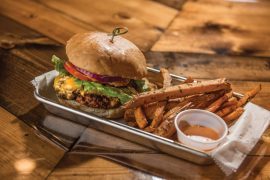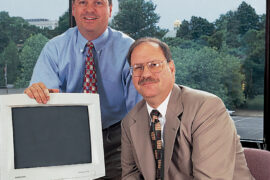By Jack Houvouras
HQ 89 | SPRING 2015
Wednesday, Dec. 17, was a typical day for Marshall University President Stephen J. Kopp. He arrived at the office shortly after sunrise and tackled some paperwork before entering a Board of Governors meeting that consumed most of the morning. Following lunch, he drove to Heritage Farm Museum & Village to meet with former Marshall Interim President A. Michael Perry and new West Virginia Senate President Bill Cole to discuss higher education issues and the upcoming legislative session. At 6 p.m. he and his wife, Jane, held a small holiday dinner party at the President’s Mansion, and following an enjoyable evening with friends and colleagues the couple said goodnight to their final guests before winding down another long day. Twenty minutes later, Kopp collapsed and died. The news spread quickly and sent shockwaves throughout the Marshall community.
“When I heard the news I was absolutely stunned,” says Dr. Joseph Touma, a Huntington developer, physician and longtime Board of Governors member. “This is a huge loss for the university and the community. What he did for both Marshall and Huntington was phenomenal.”
Board of Governors Chairman Michael Sellards shared the sentiments of thousands of alumni around the country when he stated, “Dr. Kopp was a visionary in higher education. All you have to do is look around the campus to see the legacy this man left behind. It is a legacy that will affect generations.”
Kopp was just 63 years old when he passed away unexpectedly. He is survived by his wife of 42 years, Jane; two children, Adam and Liz; and two grandchildren. He was approaching his 10-year anniversary as president of an ever-evolving and transformative university. It can easily be argued that, in its 177-year history, Marshall University never saw more growth and expansion than under the tenure of President Kopp. His list of accomplishments is vast.

Under his watch, more than $300 million was spent on new buildings and renovations of existing facilities. Some of the more notable projects include:
- Edwards Comprehensive Cancer Center
- Robert C. Byrd Biotechnology Science Center
- Expansion of the Forensic Science Center
- Veterans Memorial Soccer Complex
- New parking garage
- Renovation and rededication of the Memorial Fountain
- Recreation Center
- Four new residence halls and a new cafeteria
- Marshall University Foundation Hall / Erickson Alumni Center
- Arthur Weisberg Family Applied Engineering Complex
- Four new sky suites at the Joan C. Edwards Stadium
- Indoor Practice Complex that includes an indoor football field, track, Student-Athlete Academic Center and Sports Medicine Translational Research Center
- Visual Arts Center in downtown Huntington
- Development of the Old Main Corridor and other Fourth Avenue beautification projects
- Renovations to various facilities on both of Marshall’s campuses
- Campus-wide landscaping and beautification projects
Alumni who hadn’t visited Marshall in the last decade often commented that they didn’t recognize the expansive campus, noting the new buildings that dot the skyline. Many visitors stood in awe of how much the university had grown in such a short period.
But Kopp will be remembered for more than just the physical growth of the university. His mark on academics was equally impactful.
He instituted a strategic planning process for Marshall soon after arriving in Huntington, giving faculty, students and staff, as well as members of the community, the opportunity to provide ideas for how to improve all aspects of the university. The result was a strategic vision that stressed the importance of student success. Later, the Marshall Commitment, an 11-element action plan for advancing academic quality, was implemented.
Under Kopp’s leadership Marshall’s academic profile grew dramatically, with new high-demand majors and degree programs, including digital forensics, and the new schools of pharmacy, physical therapy and public health. In addition, the four-year undergraduate engineering program was re-established and fully accredited.
Kopp was the architect of the West Virginia Research Trust Fund legislation, a plan that matched dollar for dollar the private gifts to Marshall in support of research. The result? External funding for research doubled, including $30 million in research endowments following a successful campaign to raise $15 million in private gifts.
Finally, under Kopp’s stewardship, Marshall grew in both enrollment and the geographic area it serves. The university welcomed the largest freshman classes in its 177-year history and recently unveiled a groundbreaking initiative to recruit more international students.
President Kopp arrived at Marshall University on July 1, 2005, with a very distinguished resume. He earned a bachelor’s degree in biology from the University of Notre Dame and his Ph.D. in physiology and biophysics from the University of Illinois at Chicago. He was hired as Marshall’s 36th president following successful administrative positions with Midwestern University, Central Michigan University and Ohio University.
“The search committee voted unanimously to hire Stephen Kopp because he was a perfect fit for Marshall,” said the late A. Michael Perry, who was co-chair of the search committee. “We needed a strong leader to guide us through some very complicated arenas. After conducting extensive interviews, we knew Dr. Kopp had the intellect and experience to help us formulate a comprehensive vision for the future. He was the right leader at the right time in the history of this institution.”
More than just a visionary university president, Kopp was also extremely involved in the progress of the entire Huntington community, sharing many civic responsibilities with his wife, Jane. The couple was well respected, with a love of the region that was readily apparent. The Kopps were always proud to call West Virginia home and quickly became endeared with the people and beauty of Huntington.
The Kopps also understood the symbiotic relationship between the university and Huntington. Their support helped make possible the Old Main Corridor and other Fourth Avenue beautification projects.
Kopp led Marshall through the purchase of the former Stone & Thomas building, which today is a visual arts learning center. The former six-story department store is an anchor of the new city landscape, bringing Marshall and downtown Huntington closer together.
He regularly visited area high schools to instill in students the importance of not just starting college, but completing their degrees, if they expected to compete in the global marketplace.
Kopp was honored by Create Huntington in 2009 for his efforts to help improve the livability of Huntington. He lent his expertise to a variety of area economic development organizations, including the Huntington Area Development Council and the Huntington Regional Chamber of Commerce. He was a member of Johnson Memorial United Methodist Church and the Rotary Club and was a generous contributor to local charity fundraising efforts.
While both the Marshall and Huntington communities lost a dynamic leader on Dec. 17, the legacy of President Stephen J. Kopp will live on. It is a legacy defined by growth, expansion, research, academic enrichment and civic pride. It will affect students at Marshall University for generations.
In one of his first interviews shortly after his arrival on campus in the summer of 2005, Kopp spoke about his vision for the future.
“How do you know you’ve made a difference in a college or university?” Kopp asked. “It’s when you see the ideas, values and vision expressed every day by the people who are still there – that the vision for the future is one that is enduring.”
His words would ultimately prove to be prophetic nearly 10 years later. President Kopp may be gone, but his vision will endure.





